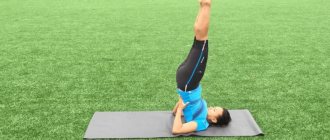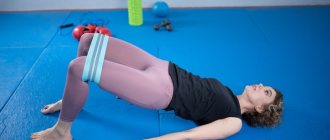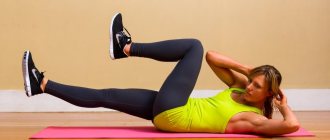Share:
The plank exercise is considered one of the most effective exercises for pumping up the abdominal muscles. This exercise gained popularity due to the simplicity of the workout and the belief that it is good for weight loss. Is it so? We will talk about this and how to do this exercise correctly in our material today.
The exercise is unique in that without equipment or exercise equipment it works several different muscle groups at the same time. These are the muscles of the abs, shoulder girdle, arms, back, legs, buttocks.
© Makatserchyk — stock.adobe.com
The plank exercise also increases the endurance of the entire body, helps you lose weight by accelerating your metabolism, and even improves your psycho-emotional state. It doesn't matter whether you prefer group CrossFit classes or individual training, it is the practice of the plank that will make other exercises safe and effective.
The plank exercise is great for cool-downs in CrossFit!
Let's talk about the following things:
- All types of planks.
- Correct plank technique.
- Benefits and harms for the body.
- How to make plank progress in 30 days.
Plank exercise: benefits and harms
Benefit
Basically, all the exercises done in training are dynamic. They are aimed at working one muscle group. The static load when performing the plank exercise acts on a muscle group and amazes with its results. Within just a few weeks, you can notice a change in your figure for the better. By doing this exercise it is possible to lose weight, as daily exercise increases metabolism. The plank can be part of a regular dynamic workout and can perfectly complement it.
Harm
For people suffering from unstable blood pressure and diseases of the cardiovascular system, this exercise is not recommended, since the pressure may rise during the exercise. For girls, a contraindication to performing this exercise is the period of PMS and pregnancy.
The benefits of the plank
Generally speaking, the bar can: – correct posture; – strengthen stabilizer muscles (responsible for balance, i.e. core muscles); – remove the load from the spine, transferring it to the muscles; – burn extra calories during training (static burns almost as much as dynamics); – tone the muscles without involving the joints (if there is a problem or injury with them); – the ability to perform even with pain and when it is impossible to perform other exercises (there is no axial load, no load on the spinal discs, but there is strengthening of the muscles of the whole body).
advertising is not displayed
Plank on hands or elbows, classic plank
There are several types of classic planks, all of which differ in the degree of load on a particular muscle group.
Plank performed with straight arms
Classic plank, performed with straight arms. You need to take a position as if you are going to do push-ups, with your body extended in one line, your neck stretched, and your gaze directed down in front of you. Hands are placed shoulder-width apart and form a 90-degree angle with the body, the stomach is pulled in as much as possible.
Classic elbow plank
The classic plank on the elbows repeats the plank on straightened arms, with the only difference that the support is not the palms, but the elbows.
Male standards: how long to keep?
Let's figure out how long men need to keep the time bar. You might be thinking that since you're a male, you should learn how to hold her for hours. There are no standards for the bar as such. I will even say more, there is no need to chase time at all.
If after 30 seconds you are already shaking as if you had been working with a jackhammer for three days, then doing the plank in this style will not bring any benefit.
Especially if you begin to bend your lower back and pull your pelvis towards the sun, this is no longer a plank at all, but meaningless suffering, which not only will not bring any benefit, but can also cause harm.
Better simple, less time, but high quality. You can gradually increase the time in the plank, the main thing is that your technique does not suffer. There is no standard for men; there are no upper limits. So how long you need to keep the bar in time is your personal business.
Progressive plank exercise
If your body easily tolerates the loads of the classic plank, you can do more difficult exercises.
Plank and push-ups
Plank with a transition from a position on your hands to a position on your elbows and back (plank - push-up). This exercise must be performed as the load increases.
Plank jump
The jumping plank is another form of progressive exercise. To perform it, you need to push off with your toes and spread your legs shoulder-width apart, pushing off a second time to return your legs to the starting position. When performing such an exercise, more significant loads are applied to the muscles.
Plank with arm extension
A simpler exercise than the previous one, but no less useful, is the plank with your arms extended forward. Removal of the hand is carried out alternately. When performing this exercise, the center of gravity changes, which forces the muscles to work differently.
Side plank
When performing a side plank, the body is on its side, supported by the foot and palm, or supported by the foot and elbow. The body is elongated in line, the hips and lower back are kept in tension without bending, the stomach is pulled in.
Progressive side plank or transition plank
When performing this exercise, you switch from a side plank to a classic plank on your elbows, followed by a transition to the other side and back.
Progressive side plank with twist
This exercise is analogous to the twisting exercise, and affects the work of the oblique abdominal muscles.
Plank with frog lunge
This exercise is very good for stretching and strengthens the gluteal muscles.
Plank on fitball and bench
Despite the similarity of this exercise with the classical variation, the number of muscles involved here is greater, since while leaning on the fitball you also need to maintain longitudinal balance.
Reverse plank
This exercise does a good job of tightening the buttocks, evenly distributing the load on the shoulder muscles and stretching them. You can enter the stand from a sitting position, leaning on your palms - straighten your body. When performing the exercise, just like in the classic plank, the body should be in one line.
How many sets of planks should you do in one workout?
Each of us dreams of having a beautiful, toned figure. But it’s not always possible for a person to devote time to a full workout in the gym.
But there is a very simple exercise, the regular implementation of which will allow you to quickly achieve the desired result. This exercise is a plank.
Used in fitness, Pilates and yoga, this exercise is considered one of the most effective today. Let's take a closer look at how the plank exercise is performed and how many approaches you need to do.
Main benefit
We can talk about the benefits of this exercise for quite a long time. To begin with, doing the plank affects the main muscle groups.
It is important to consider: the plank is a static exercise. In other owls, when performing it, a person does not make any movements
At the same time, the muscles of the abdomen, back, arms, legs and buttocks are very tense, and one might say, they are actively working.
What does the bar give?
It strengthens the muscle corset, makes the stomach more toned, legs – slender, and buttocks – rounded.
With regular exercise, the back muscles are strengthened (and this has a beneficial effect on the condition of the spine), metabolism and blood pressure are normalized, sleep and mood are improved, irritability and depression disappear.
Execution Rules
The plank exercise is very simple to perform. Starting position - lying on your stomach, arms bent at the elbows, resting on the floor.
It is important to take into account that the elbows should be exactly under the shoulders. Leaning on your fingertips, you need to lift your body so that it forms a straight line
The emphasis is on the arms and legs, the back is straight, the abdominal and leg muscles are as tense as possible. It is very important to avoid arching your lower back - otherwise the effectiveness of the exercise will be lost and the risk of injury will increase.
For those who have not previously engaged in sports, the first time should hold the bar for 20-30 seconds. Then - a short break and repetition of the exercise. It is advisable to do 3-5 approaches at a time. When performing the plank exercise regularly, approaches should gradually be made longer.
Note!
That is, for a week, morning and evening, stand in the plank for 30 seconds (and so 5 approaches). Next week you can increase the duration of execution to 40-45 seconds, then to a minute.
In fact, the number of approaches of the plank exercise depends solely on the physical condition of the person. So, someone can easily do 5 approaches of 2 minutes, while others find it difficult to do 3 approaches of 30 seconds. Therefore, beginners should not immediately try to do the exercise for as long as possible - excessive stress on unprepared muscles can lead to certain problems.
For those who have been doing the plank exercise for a long time, the number of approaches can be increased. Or just start doing more complicated options:
- on one arm (side plank);
- on one arm and one leg;
- with weighting;
- with twists;
- on fitball.
But these exercises are suitable only for those whose body is prepared by regular and long-term (at least 6-9 months) performance of the classic plank.
We recommend watching a useful video with the technique of performing the exercise.
Mistakes when performing the plank exercise
Back bend
The most common mistake when performing the exercise is arching your back. This error occurs due to undeveloped back muscles or due to ignorance of how to correctly perform this exercise.
Knee bending
If your knees are bent while performing the exercise, this affects the overall position of the hips, which in turn can cause discomfort when performing the exercise.
Tucking your head under or lifting it too high
If the head is positioned incorrectly, pain in the cervical spine may occur. The neck should be located almost in line with the spine.
Incorrect palm placement
When performing a classic hand plank, your palms should be at shoulder level. When doing planks on your elbows, the same rule applies. Incorrect hand placement is very common among those who have recently started doing it.
How many times a day should you do planks to lose weight? Regularity of training
When starting to complete the plank, some people note with dissatisfaction that the result is insignificant or completely absent. The reasons for this state of affairs may be that you are not in the best physical shape or that you have not performed enough approaches. For example, you should not expect quick results if you spend 1-2 minutes a day doing the exercise. Therefore, first of all, it is recommended to increase the duration and frequency of exercises.
It is impossible to answer unequivocally how many times a day you should do the plank. Much depends on the physical form of a person. But, even if you only have enough strength to stand in the plank for about a minute, then you need to do the exercise not once a day, but 3-4 times.
At the same time, if you feel significant discomfort or pain after performing the exercise (most often they complain about pain in the back), then it is advisable to completely stop doing the exercise and consult a doctor.
In some diseases (intervertebral hernia, spinal injuries), the bar can cause significant harm to health. Increasing the number of approaches will only make the situation worse.
How many times a day to do the plank directly depends on the goal you want to achieve.
So, if you just need to tighten the muscles a little, give them relief, two approaches a day for 2-3 minutes each will be enough. But if you intend to use the bar as a tool for weight loss, then it is advisable to at least double the number of approaches.
Please note: being a static exercise, the plank burns only a small amount of calories.
Its help for weight loss is somewhat different: it helps strengthen muscles and increase flexibility. And they are necessary in order to perform more effective exercises for weight loss.
Often, just starting classes, people are interested in how many sets of planks to do at a time? It also depends on your physical condition. Some are able to stand freely for 2 minutes the first time, while others stop doing it after 20 seconds.
In the first case, one approach will be sufficient. Their number can be increased over time, when the body is prepared for increased stress. But, if a person can hold the plank for no more than 20-30 seconds, to achieve the effect, you should take a break (10-20 seconds) and perform the exercise again.
By doing the plank correctly several approaches 2-3 times a day, you will soon see that holding the plank becomes easier, and your body begins to change literally “before your eyes.”
How is the plank useful for women?
For women, this exercise is a real salvation from:
- Scoliosis and uneven gait. It's no secret that a curved spine affects the way you walk, as well as your overall posture. The plank trains the spinal muscles and straightens the intervertebral discs. Thanks to this, they fall into place, the ridge gradually straightens. Under the influence of this process, the gait is aligned and posture is significantly and noticeably improved. And for a woman it plays a huge role not only in terms of health, but also in the aesthetic aspect.
- Saggy belly.
Constantly keeping the transverse muscles in a tense state contributes not only to the visual, but also to the physical tightening of sagging skin. It can begin to sag for any reason - both under the influence of the biological processes of aging, and against the background of sudden weight loss. But to get rid of such a defect, you need to train hard and daily. The only exceptions are “special” days for women. - Fat folds on the hips, sides, buttocks. The plank is unique, one of the few universal static exercises that forces the body to work almost completely. That is, only the muscles of the neck and head are not involved. The remaining muscle groups, one way or another, are subject to stress. Thus, pressure is exerted on fat cells, which gradually begin to break down. This is a long process, so the woman’s endurance is extremely important here.
Equally important is the positive effect of exercise on the respiratory system and brain. Intensive ventilation of the lungs helps saturate the cells with oxygen, while simultaneously removing remaining carbon dioxide from them. This affects the work of all organs and systems without exception - endocrine, cardiovascular, nervous. The reproductive sphere of women is also subject to a beneficial effect, since training has a positive effect on hormonal levels.
See also:
What to do with aching pain in the heart and the reasons for the symptom
What muscle groups work
Exercise strengthens the muscles of the abdomen, chest, back, shoulders, hips, and buttocks. What is relevant for people who lead a sedentary lifestyle.
If you follow the technique of performing the load, the exercise brings benefits:
- Strengthens your back. This is especially important when working sedentarily.
- Reduces pain in the neck and spine, which is why it is included in exercise therapy.
- Increases endurance because staying in the correct position for more than 30 seconds requires a lot of effort.
- Improves blood circulation, supplying organ cells with oxygen.
- Activates the production of the hormones dopamine and serotonin, which leads to improved mood.
Groups of working muscles are supplemented under different types of load.
How to do the exercise correctly?
If the exercise is performed incorrectly, it is impossible to pump up the abs and tone the body. The body position in the plank should look like this:
Wherein:
- Feet should be placed together. This will increase the load on the abdominal muscles.
- Legs must be kept tense and straight. Otherwise, the load on the abdominal muscles will be significantly reduced.
- The buttocks should be tense throughout.
- The lower back should not be arched or rounded. The lumbar region should remain flat.
- The stomach should be pulled in and try to be pulled towards the ribs. Do not hold your breath.
- The elbows should be placed clearly under the shoulder joints: this will relieve your arms from unnecessary stress.
If during the exercise there is discomfort or severe nagging pain in the lower back, it means that the plank is being performed incorrectly.
Features of performance for men and women
Men's and women's straps are slightly different. This happens because the male body is naturally stronger and more resilient than the female body.
This is why plank times are different for women and men:
- Women need to start with 20-25 seconds. and perform 3 approaches. This is enough for the first week of training. In the second week, the time can be increased by 10–15 seconds. and add another approach. You need to continue adding time in this way until it reaches two minutes.
- Men can start doing planks from 45 seconds. 4 approaches each. Every week you should add 15 seconds. and one approach. If a young person has previously been involved in sports, it is recommended to do the plank in the morning and evening.
- Girls who have previously visited the gym can do the plank twice a day for 30–35 seconds. in 3–4 trips. The stand time can be increased by 10 seconds every week.
These are general recommendations
You should pay attention to your physical condition, as well as the degree of muscle training
Men can resort to this type of exercise only to give general muscle tone or to warm them up. The plank is a static, not a dynamic exercise. It is called that because it does not require a large number of movements, so there can be no talk of any gain in muscle mass.
What are we observing? Plank!
And we are observing the so-called bar!
Plank is trading jargon. Occurs when the price of an asset during the day reaches certain maximum deviations from the closing price of the previous day. This deviation is correctly called the “price limit” or in English: Price Limit.
Price limits (Price Limit) are strictly regulated and specified in the specifications of each futures. If you open our futures specifications page, you can see that each futures is clickable. Select E-Mini S&P 500 futures as an example.
A page describing the specifications will open on the CME Group exchange website. Now we are interested in the bottom of the page:
Click on Price Limits, enter the ticker we need esh0 for simplicity and see the following:
As we can see, there are 4 price limits (Price Limit) or in trading jargon - 4 levels. Deviation of 5%, 7%, 13% and 20% deviation. Moreover, for the first level of 5%, it works for both growth (up) and fall (down). But subsequent planks only work for falling.
In the figure, I highlighted the value of the first level of decline at 2819, which we saw above on the chart and in the order book for the E-Mini S&P 500.
In the figure in the first column header the hours when the bar is in effect are indicated. More complete expansion rules are listed at the top of the page. Let me quote from there:
CME Group US equity index price limits (and corresponding CME and CBOT rules) are designed to coordinate with circuit breakers provisions as applied by the New York Stock Exchange (NYSE). 7%, 13%, and 20% price limits are applied to the futures fixing price and are effective from 8:30 am CT – 2:25 pm CT. Mondays through Fridays. From 2:25 pm to 3:00 pm CT, only the 20% price limit will be applied to the futures price fixing. 5% up-and-down limits are effective 5:00 pm — 8:30 am CT. Sundays through Fridays; and 3:00 pm — 4:00 pm CT, Mondays through Fridays. Between 3:00 pm — 4:00 pm the 5% price limit will not be allowed to breech the 20% daily limit. The fixing price is the volume weighted average price, VWAP, calculated during the 30 seconds of trading from 2:59:30 pm – 3:00:00 pm
Here we are interested in the phrase that concerns the first 5% bar: “5% up-and-down limits are effective 5:00 pm - 8:30 am CT “As we see, this bar is valid until 8:30 am CT. CT stands for North American Central Time. Difference with Moscow time in summer: 8 hours. Thus, this bar is valid until 16:30 Moscow time.
At 16:30 Moscow time the price limit will be expanded and will be able to move up to the next level of 7%. Which is already determined by the exchange in advance and is equal to 2759.5 And so on.
The above values are relevant only for one date - for March 9, 2022. When you read this article, the data will be different, you can always view it using the links above.











